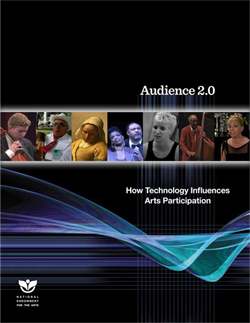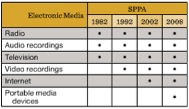Audience 2.0 - Condensed, Part I
 In part I of this two-part post, I summarize the findings of Audience 2.0, while tackling the problems, questions and lack of answers in part II. Audience 2.0: How Technology Influences Arts Participation, the newest study released by the National Endowment of the Arts gives empirical quantitative data to support how technological trends affect arts participation, the health of the arts in the US, and the ways that arts patrons use electronic media to engage in the arts.
In part I of this two-part post, I summarize the findings of Audience 2.0, while tackling the problems, questions and lack of answers in part II. Audience 2.0: How Technology Influences Arts Participation, the newest study released by the National Endowment of the Arts gives empirical quantitative data to support how technological trends affect arts participation, the health of the arts in the US, and the ways that arts patrons use electronic media to engage in the arts.
Audience 2.0 takes data from the NEA’s 2008 Survey of Public Participation in the Arts and the three other SPPA studies from 1982, 1992, & 2002 and “examines how Americans participate in the arts via electronic and digital media.” The media platforms: Radio, Audio recordings, Television, Video Recordings, Internet, & Portable Media Devices were tracked, but there is not consistant data available from every study.

The study cited three main conclusions:
- Technology is not going to be the downfall of live performances, the arts or culture in our society,
- Technology provides a new outlet for people to experience the arts who may not otherwise have participated at all.
- Participation in the arts through electronic and digital media actually spurs participation in live arts performances and exhibitions.
The study found that “people who engage with art through media technologies attend live performances or arts exhibits at two to three times the rate of non-media arts participants.” This statistic should quell many of the concerns arts organizations have about digital media replacing them and help arts institutions embrace technology as a way to reach enrich their patrons. The study shows that technology provides a way for people to interact with arts and culture outside of the traditional venue, but it does not replace attending the physical arts or event space.
“53% of US adults used TV, radio, CDs/DVDs, computers or portable media devices to view or listen to arts performances, programs about artists, art works, museums or programs about literature.” Far more people participate in the arts as a whole than those who physically attended arts events. This shows a greater interest in arts and culture from Americans than many people had previously thought.
“For every arts performance outlet besides theater, adults were more likely to view or listen through electronic media than to attend live events.” This statistic has many people concerned about the impact of technology on the arts, however; the data shows this to be a good thing because a majority of the participants who make up the media only category represent people who would never have attended an arts event in the first place. The NEA then draws the correlation that these people would not participate in the arts at all without media and electronic technology outlets. Technology helps to widen the breadth of reach for the arts and allows people to participate in the through new portals.
Adults who used electronic media and technology only to participate in the arts had a higher likelihood of lower-than-average household incomes, residing in rural residents, belong to racial and ethnic minorities, belonging to that age group 75+, and/or having achieved no more than some college in their life. This profile directly mirrors the profile of people who do not participate in benchmark arts events at all.
The big picture of this survey is that it really just repeated many of the SPPA findings from the past three decades through the lens of technology. Overall, Education still has the greatest weight in determining arts participation, racial and ethnic minorities participate less than non-Hispanic whites, and racial and ethnic minorities tend to participate more frequently in arts event that are associated with their heritage.
This study leaves more questions than answers and those will be tackled in part II of this series.